Interestingly, given the way history wrote itself, the Ford New Holland 40 Series saw a number of updates and changes through its entire five-year production run, some obvious, some not so much.
Coincidentally, this resulted in multiple deviations of the one model. In livery alone, the series witnessed three notable changes from 1992 to 1997, starting with the early white roof models before transitioning to the blue roof.
This was then followed by the arrival of the joint Ford/New Holland branding before the Ford name was dropped to just New Holland before production came to an end.
Based just outside Tullow, Co Carlow, Jeremy O’Toole runs an agricultural contracting business alongside the family dairy farm. Aside from a modern fleet of Valtra and Fendt tractors, Jeremy also works a couple of older modern working classics including a 2002 Valtra 8050 and a 2000 Massey Ferguson 4215.
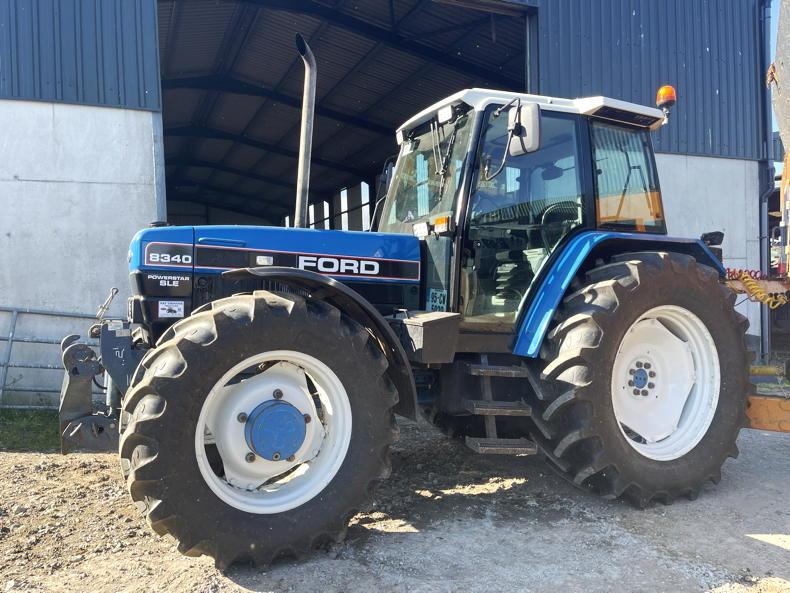
Jeremy's 1995-registered Ford 8340 was one of the very last white-roofed Ford models manufactured.
In 2021, he looked at replacing one of the farm’s classics, a David Brown 1290, for something a little more capable.
Modern working classic
“With things getting busier, I needed an extra tractor at certain times of the year, something that could earn its keep when called upon at a reasonable price.
“After initially looking, I spotted a John Deere 6800 down at local dealers Pat Timmins Tractors, so I went for a look and it turned out to be immaculate.
“Pat and Karl Timmins, known for their Ford and New Holland expertise recommended a 40 series for what I was after, more so an 8340 for the extra power. I had previously owned two 7840s up through the years but never an 8340, a tractor I always liked. This got me thinking,” Jeremy said.
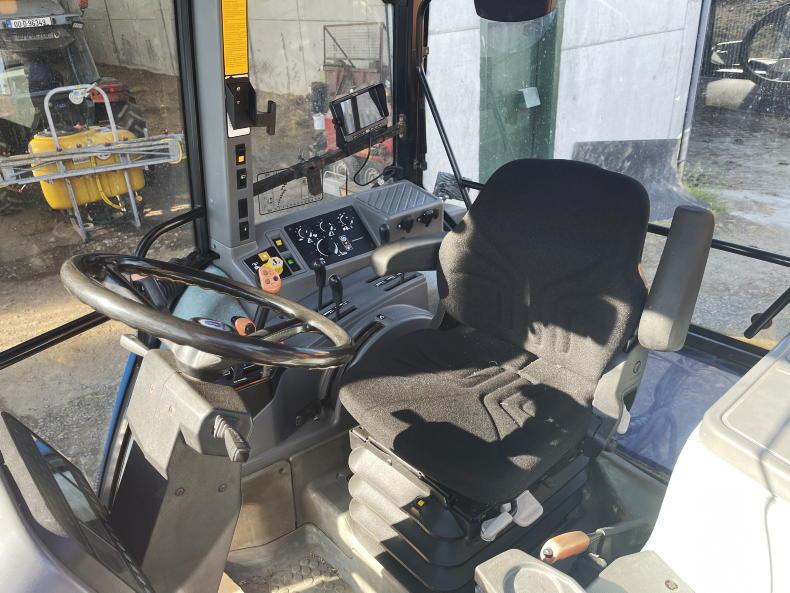
Jeremy has replaced the original seat for an OEM looking black Grammer air seat.
“There were never many 8340s sold new in the southeast, especially the earlier Ford models, leaving them that bit more rare.
“There were rumours that white roof models were a slight bit more troublesome given that the gearbox solenoids were internal. However, this was only the earlier models pre 1993,” Jeremy explained.
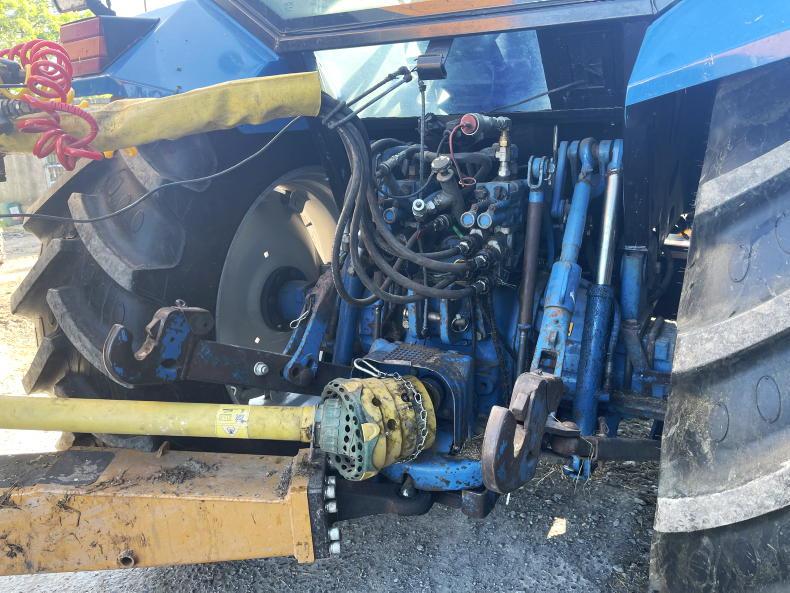
The 8340 models were fitted with a heavier backend compared to the 7840 models.
“There were three 8340s in the yard that day to choose from, one New Holland, one Ford New Holland and the worst looking one, a white-roofed Ford model. The white-roofed tractor stood out to me. It was one of the last white-roofed models and so came factory-fitted with a turbo. It was original, the panels were straight with only a small bit of rust below the cab doors.
“It was an import from Norway so ended up being a 30km/h model. I took it home anyway to see how it would perform. It done everything we put its way with ease. I was impressed.”
As part of the deal, Jeremy had the lads at Timmins Tractors convert it to 40km/h and tidy it up cosmetically. Otherwise, it was running mechanically perfect.
“They sent the cab and panels down to Bob Rowe in Co Wexford to be repaired and painted. The chassis was quite tidy so I kept it original. Agrigear painted the rims and fitted new BKT tyres. The lads all did an excellent job,” Jeremy said.
Other modifications completed by Jeremy include fitting LED work lights and headlights, Jeremy replaced the original seat with a more comfortable OEM-looking black Grammer air seat. The front linkage was also swapped for a neater LaForge unit.
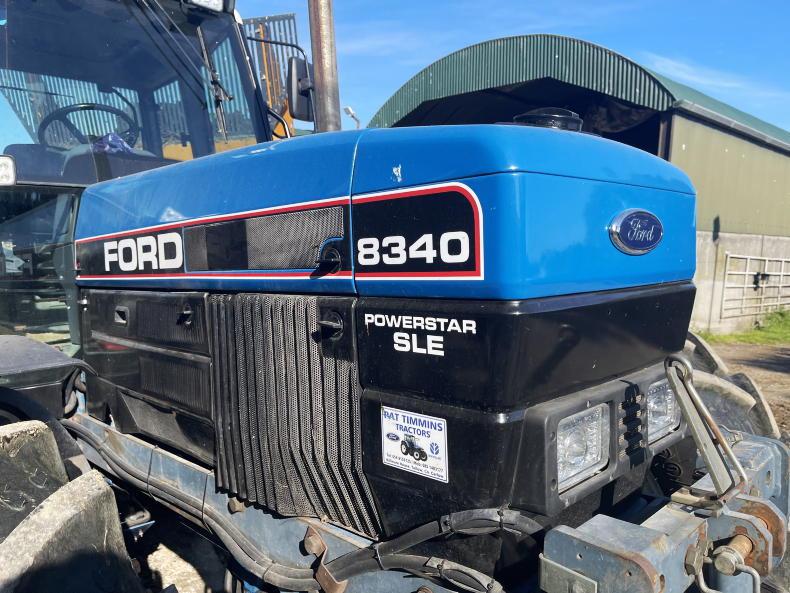
The last of the Ford branded tarctors were built in 1995.
Since the tractor arrived in spring 2021 with 7,300 hours as a hobby/spare tractor, it’s clocked up over 900 hours, meaning it certainly hasn’t been idle.
“It’s a real fun, lively tractor to drive. I fitted it with a Power Beyond kit and since it’s worked everything from the McHale Fusion, to the Richard Western muck spreader. It’s also raked and pulled a 20ft Broughan trailer and 4,000-gallon slurry tanker with no issue.
“This autumn, it worked the 6.6m paddle roller in front of two drills with no issue. The tractor was dyno-tested by Agritune making 140hp at the PTO shaft which it’s doing at ease, thanks to that under stressed 7.5l engine.”
One of the only things not working on the tractor when it arrived, according to Jeremy, was the air-conditioning which he had sorted.
Aside from the lack of suspension, it’s got all the modern refinements you’d need, yet it still feels raw like how tractors used to feel.
“It’s a tractor everyone enjoys operating and an example I can’t see myself parting with,” Jeremy said.
Ford first announced its 40 Series in 1991 as the successor to its ageing TW and 10 Series tractors.
Somewhat a blank canvas at the time, it laid foundations for a completely new range from the ground up aside from the carryover of a few proven components.

The 40 Series cab layout was completely new to the 10 Series that came before it.
Initially, the range consisted of the 5640 (4cyl 75hp), 6640 (4cyl 85hp), 7740 (4cyl turbo 95hp), 7840 (6cyl 100hp), 8240 (6cyl 110hp) and the flagship 8340 (6cyl 120hp).
Transmissions
The 40 Series offered three 40km/h transmission options, the SL, SL Dual Power and SLE.
The basic SL 12Fx12R option comprises four manual gears with three ranges (low, medium, high) and a mechanical shuttle lever. Next up is the 24Fx24R SL Dual Power, similar to that in the earlier 10 Series models.
Its functionality was practically the same as the SL only with the addition of button activated splitters positioned on the gearstick, doubling the number of gears.
Then there was the 16Fx16R Electroshift semi-powershift transmission fitted as standard in SLE models. It featured two gears with four powershifts in each.
Once in fourth gear, the lever had to be pushed forward to engage gears five to eight. Both the SL Dual Power and SLE Electroshift had an additional high and low range gear lever and a manual shuttle lever which featured an integrated clutch button from 1993 onwards.
As mentioned already, transmission solenoids on early SLE models (pre-1993) were positioned internally which were changed afterwards and moved externally.
Internal solenoids meant opening the unit in the event of an issue, proving quite a bit more costly and time-consuming. Another update believed to have been introduced in 1993 was the move away from linkage-operated gears to cable for smoother shifting.
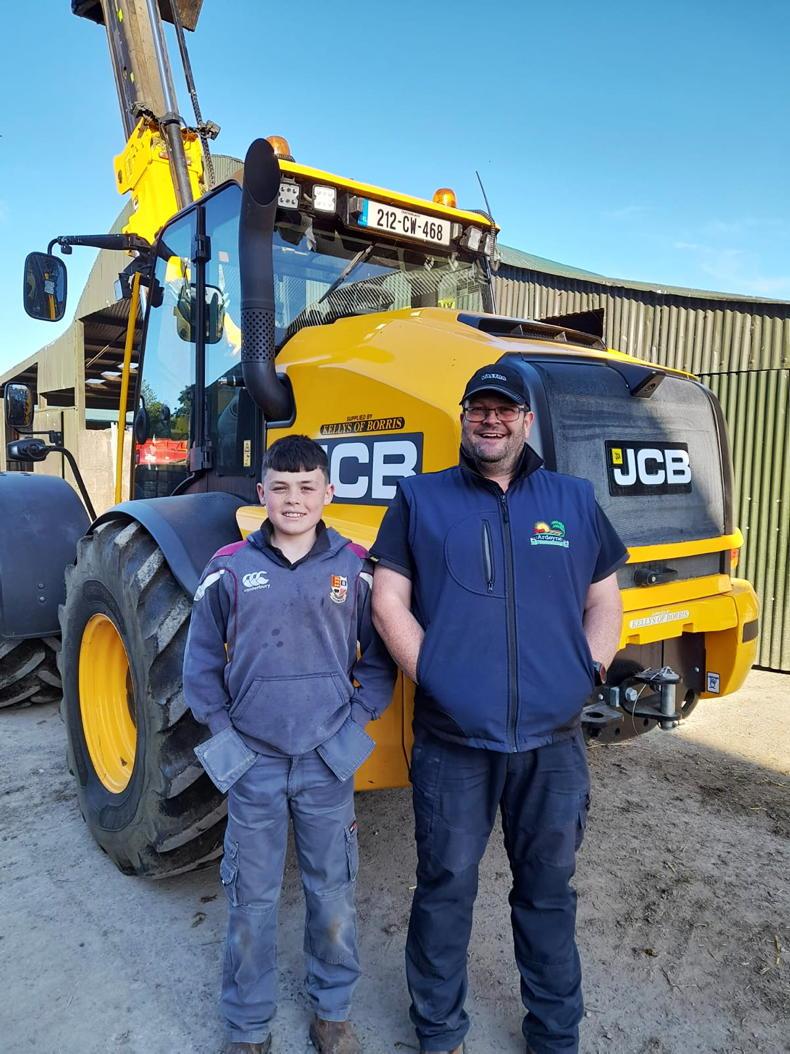
Jeremy O'Toole and his son, Fergal.
Other standard features of SLE models included electronic linkage control and a closed centre hydraulic pump.
Engine
Predecessor models to Ford’s 40 Series were known for their engines going porous. So, Ford knew that this was an area needing to be addressed and so it was with the arrival of the Powerstar units fitted in its 40 Series tractors. To this day, these 6.6l (7840) and 7.5l (8240 and 8340) six pot units are well regarded in terms of performance and reliability.
Early 8340 models built between 1991 and 1994 were non-turbo and produced 120hp. From 1994 onwards a turbo’d version was fitted which saw output increase marginally to 125hp.
After Fiat’s 80% buyout of Ford New Holland, the official merging of the two names to form New Holland happened in 1995. Aside from the roof going from white to blue and chassis from blue to grey, the front axles changed from Carrero to Fiat. Minor changes were also made to the dash, interior and electrics.
By the end of 1996, all tractors were now fully badged and branded as New Holland with the removal of the Ford lettering below the model number. Rear mudguards went from metal to a more durable moulded plastic.
Lift controls also changed and so did cab handrails which were lengthened and new mounting point for work lamps. Dynamic ride control became an option at this point to help cushion heavy rear linkage mounted implements.
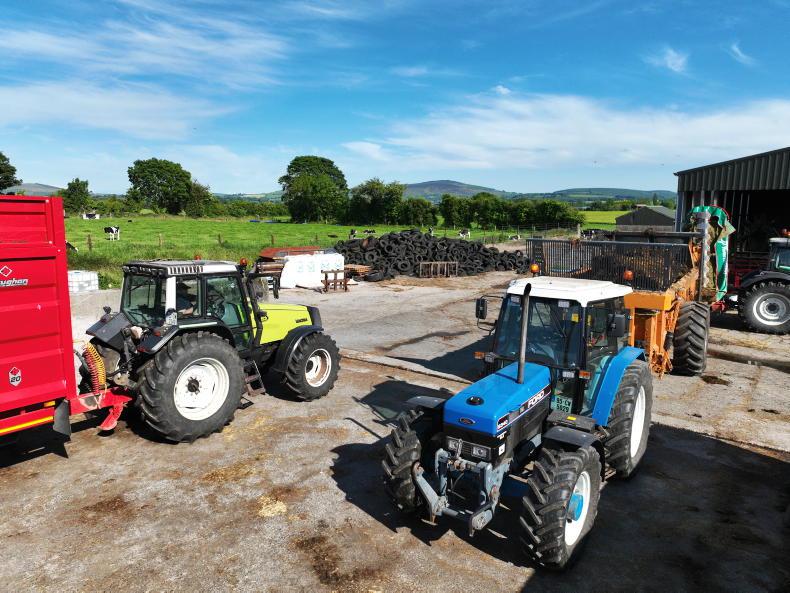
Jeremy's Ford 8340 and Valtra 8050 side by side.
Engine: 7.5l six-cylinder turbo.Horsepower: 125hp.Transmission: 16Fx16R Electroshift semi-powershift. Hydraulics: 75.7l/min closed centre load sensing. Weight: 4,936kg.Lift capacity: 2,997kg (3,950kg optional).Wheelbase: 2.62m.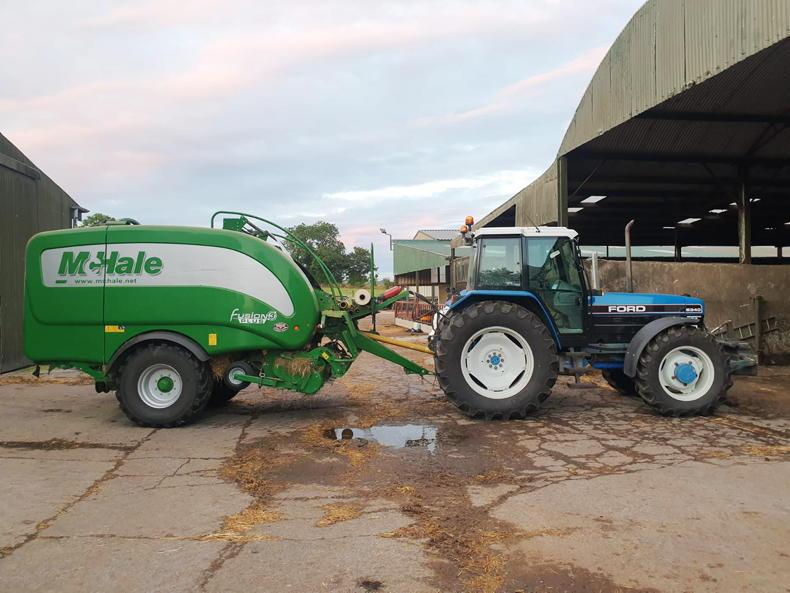
Jeremy had his 8340 fitted with power beyond so that it could handle the Fusion 3 baler.
Interestingly, given the way history wrote itself, the Ford New Holland 40 Series saw a number of updates and changes through its entire five-year production run, some obvious, some not so much.
Coincidentally, this resulted in multiple deviations of the one model. In livery alone, the series witnessed three notable changes from 1992 to 1997, starting with the early white roof models before transitioning to the blue roof.
This was then followed by the arrival of the joint Ford/New Holland branding before the Ford name was dropped to just New Holland before production came to an end.
Based just outside Tullow, Co Carlow, Jeremy O’Toole runs an agricultural contracting business alongside the family dairy farm. Aside from a modern fleet of Valtra and Fendt tractors, Jeremy also works a couple of older modern working classics including a 2002 Valtra 8050 and a 2000 Massey Ferguson 4215.

Jeremy's 1995-registered Ford 8340 was one of the very last white-roofed Ford models manufactured.
In 2021, he looked at replacing one of the farm’s classics, a David Brown 1290, for something a little more capable.
Modern working classic
“With things getting busier, I needed an extra tractor at certain times of the year, something that could earn its keep when called upon at a reasonable price.
“After initially looking, I spotted a John Deere 6800 down at local dealers Pat Timmins Tractors, so I went for a look and it turned out to be immaculate.
“Pat and Karl Timmins, known for their Ford and New Holland expertise recommended a 40 series for what I was after, more so an 8340 for the extra power. I had previously owned two 7840s up through the years but never an 8340, a tractor I always liked. This got me thinking,” Jeremy said.

Jeremy has replaced the original seat for an OEM looking black Grammer air seat.
“There were never many 8340s sold new in the southeast, especially the earlier Ford models, leaving them that bit more rare.
“There were rumours that white roof models were a slight bit more troublesome given that the gearbox solenoids were internal. However, this was only the earlier models pre 1993,” Jeremy explained.

The 8340 models were fitted with a heavier backend compared to the 7840 models.
“There were three 8340s in the yard that day to choose from, one New Holland, one Ford New Holland and the worst looking one, a white-roofed Ford model. The white-roofed tractor stood out to me. It was one of the last white-roofed models and so came factory-fitted with a turbo. It was original, the panels were straight with only a small bit of rust below the cab doors.
“It was an import from Norway so ended up being a 30km/h model. I took it home anyway to see how it would perform. It done everything we put its way with ease. I was impressed.”
As part of the deal, Jeremy had the lads at Timmins Tractors convert it to 40km/h and tidy it up cosmetically. Otherwise, it was running mechanically perfect.
“They sent the cab and panels down to Bob Rowe in Co Wexford to be repaired and painted. The chassis was quite tidy so I kept it original. Agrigear painted the rims and fitted new BKT tyres. The lads all did an excellent job,” Jeremy said.
Other modifications completed by Jeremy include fitting LED work lights and headlights, Jeremy replaced the original seat with a more comfortable OEM-looking black Grammer air seat. The front linkage was also swapped for a neater LaForge unit.

The last of the Ford branded tarctors were built in 1995.
Since the tractor arrived in spring 2021 with 7,300 hours as a hobby/spare tractor, it’s clocked up over 900 hours, meaning it certainly hasn’t been idle.
“It’s a real fun, lively tractor to drive. I fitted it with a Power Beyond kit and since it’s worked everything from the McHale Fusion, to the Richard Western muck spreader. It’s also raked and pulled a 20ft Broughan trailer and 4,000-gallon slurry tanker with no issue.
“This autumn, it worked the 6.6m paddle roller in front of two drills with no issue. The tractor was dyno-tested by Agritune making 140hp at the PTO shaft which it’s doing at ease, thanks to that under stressed 7.5l engine.”
One of the only things not working on the tractor when it arrived, according to Jeremy, was the air-conditioning which he had sorted.
Aside from the lack of suspension, it’s got all the modern refinements you’d need, yet it still feels raw like how tractors used to feel.
“It’s a tractor everyone enjoys operating and an example I can’t see myself parting with,” Jeremy said.
Ford first announced its 40 Series in 1991 as the successor to its ageing TW and 10 Series tractors.
Somewhat a blank canvas at the time, it laid foundations for a completely new range from the ground up aside from the carryover of a few proven components.

The 40 Series cab layout was completely new to the 10 Series that came before it.
Initially, the range consisted of the 5640 (4cyl 75hp), 6640 (4cyl 85hp), 7740 (4cyl turbo 95hp), 7840 (6cyl 100hp), 8240 (6cyl 110hp) and the flagship 8340 (6cyl 120hp).
Transmissions
The 40 Series offered three 40km/h transmission options, the SL, SL Dual Power and SLE.
The basic SL 12Fx12R option comprises four manual gears with three ranges (low, medium, high) and a mechanical shuttle lever. Next up is the 24Fx24R SL Dual Power, similar to that in the earlier 10 Series models.
Its functionality was practically the same as the SL only with the addition of button activated splitters positioned on the gearstick, doubling the number of gears.
Then there was the 16Fx16R Electroshift semi-powershift transmission fitted as standard in SLE models. It featured two gears with four powershifts in each.
Once in fourth gear, the lever had to be pushed forward to engage gears five to eight. Both the SL Dual Power and SLE Electroshift had an additional high and low range gear lever and a manual shuttle lever which featured an integrated clutch button from 1993 onwards.
As mentioned already, transmission solenoids on early SLE models (pre-1993) were positioned internally which were changed afterwards and moved externally.
Internal solenoids meant opening the unit in the event of an issue, proving quite a bit more costly and time-consuming. Another update believed to have been introduced in 1993 was the move away from linkage-operated gears to cable for smoother shifting.

Jeremy O'Toole and his son, Fergal.
Other standard features of SLE models included electronic linkage control and a closed centre hydraulic pump.
Engine
Predecessor models to Ford’s 40 Series were known for their engines going porous. So, Ford knew that this was an area needing to be addressed and so it was with the arrival of the Powerstar units fitted in its 40 Series tractors. To this day, these 6.6l (7840) and 7.5l (8240 and 8340) six pot units are well regarded in terms of performance and reliability.
Early 8340 models built between 1991 and 1994 were non-turbo and produced 120hp. From 1994 onwards a turbo’d version was fitted which saw output increase marginally to 125hp.
After Fiat’s 80% buyout of Ford New Holland, the official merging of the two names to form New Holland happened in 1995. Aside from the roof going from white to blue and chassis from blue to grey, the front axles changed from Carrero to Fiat. Minor changes were also made to the dash, interior and electrics.
By the end of 1996, all tractors were now fully badged and branded as New Holland with the removal of the Ford lettering below the model number. Rear mudguards went from metal to a more durable moulded plastic.
Lift controls also changed and so did cab handrails which were lengthened and new mounting point for work lamps. Dynamic ride control became an option at this point to help cushion heavy rear linkage mounted implements.

Jeremy's Ford 8340 and Valtra 8050 side by side.
Engine: 7.5l six-cylinder turbo.Horsepower: 125hp.Transmission: 16Fx16R Electroshift semi-powershift. Hydraulics: 75.7l/min closed centre load sensing. Weight: 4,936kg.Lift capacity: 2,997kg (3,950kg optional).Wheelbase: 2.62m.
Jeremy had his 8340 fitted with power beyond so that it could handle the Fusion 3 baler.














 This is a subscriber-only article
This is a subscriber-only article






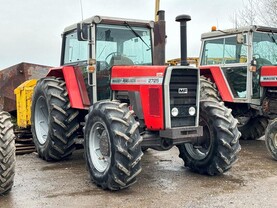


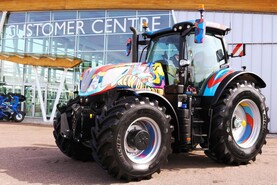
SHARING OPTIONS: